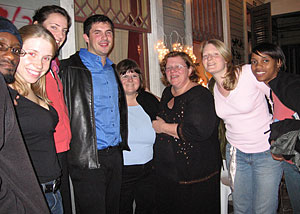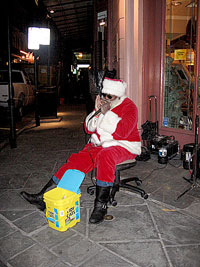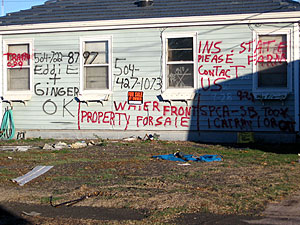Campus News
UAlbany SPH Team Volunteers in New Orleans
by Greta Petry (January 30, 2006)
 |
| University at Albany School of Public Health students with Louise-Anne McNutt, Ph.D. |
Six graduate students and three faculty members from the University at Albany's School of Public Health had a very different winter break this year.
"Christmas in the French Quarter was inspiring…and bizarre," wrote Amanda Young, an M.P.H. student in epidemiology who kept a log of the trip. "Gaudy Christmas displays adorned the balconies that normally serve for the flinging of Mardi Gras beads. Santa Claus played Walking in a Winter Wonderland on the blues harmonica, collecting tips in an empty bucket of kitty litter."
The group drove 28 hours Dec. 20 in a rented minivan to volunteer for the Bureau of HIV/AIDS Epidemiology and Prevention Services of Louisiana's Department of Health & Hospitals. "Like everyone else in Louisiana, the staff (once 40, now 10) had mostly evacuated and those left were emotionally and physically drained," Young wrote. The Albany crew helped with the backlog of work and provided respite for staff members who wanted to spend the holidays with their families. The students tackled mounds of paperwork that needed to be filed, organized, entered as data, and shredded. "The staff were trying to keep up their normal HIV-prevention and surveillance duties as well as trying to track their ‘clients' as they disappeared all over the U.S.," Young wrote. This was no small task.
 |
Santa played
the harmonica. |
"Every person who gets tested for HIV has a form filled out and sent to the DOH. For every positive test result, an investigator is sent out to find the infected person and convince them to divulge every sexual or needle sharing partner they've had since the onset of the infection." The investigator's job is to "track down the partners and convince them to come to the clinic for an HIV test," Young wrote.
Faculty members who made the trip were: Louise-Anne McNutt, Ph.D., associate professor in the Department of Epidemiology and Biostatistics; Punkin Clay Stephens, P.A., assistant professor in the same department; and Carol Whittaker, an associate clinical professor in the Department of Health Policy, Management, and Behavior. Stephens and Whittaker are full-time employees of the New York State Department of Health, and Whittaker is also assistant dean for public health practice at the SPH. Joining Young on the trip were students Dan Reynolds, an M.S. student in biostatistics; Munyaradzi Masawi of Zimbabwe, an M.S. student in epidemiology; Kimberley Gordon, an M.P.H. student in health policy and management; Eileen Bosso, an M.P.H. student in epidemiology; and Kate Rose Bobseine, an M.P.H. student in behavioral health/community health.
"It was a two-week experience of sharing sadness and grief with those who had lost so much and of experiencing uncertain hope for the future of that city and so many others along the Gulf Coast battered by hurricanes Katrina and Rita in late August and September," noted Whittaker, who also recorded her experiences.
During their stay, the UAlbany team conducted prevention, surveillance, service, and evaluation projects. Surveillance means reorganizing case files and conducting field assessment of areas known to be centers of high-risk behavior, to determine where residents and businesses were returning to the city.
In their off hours, the Albany students saw the New Orleans that remained months after the hurricanes. "We spent Christmas day in the Lower Ninth Ward," said Young. "We were there for three hours and saw maybe two other people the entire time. Every neighborhood was completely deserted and completely silent except for the occasional creaking of some hinge or flapping of some fabric off in the distance."
Whittaker said, "East New Orleans, the Lower Ninth Ward, and Gentilly appear to be nearly untouched since the flood waters receded. Hadn't any actions been taken in four months?"
Young noted, "We didn't see the worst of it. New Orleans is the home base for a lot of debris-removal teams who drive daily along the coast to help clean up. They remind me of cowboys (maybe it's just because a lot of them are from Texas)…They told us about whole communities that look like they've been put in a food processor. One man told me he'd found a dead body in a tree the week before."
 |
An abandoned
home. |
Whittaker said there was a residue on streets, yards, and in the abandoned homes which is oily, but breaks into dust particles when one steps on it.
"Whatever it is composed of, it has the power to destroy lawns, for all the grass and shrubbery are dead," she said. "The abandoned neighborhoods are quiet and colorless – you hear no birdsong or dogs barking, and there are no flowers, just dangling electric wires and the crunch of your shoes on the pavement."
The group found its volunteer placement through colleagues at the Louisiana State Department of Health and Hospitals. The volunteers stayed in a hotel in the French Quarter (only one cockroach!, Young observed,) and walked to work. Gracious staff members invited the group to their homes for birthday and holiday get-togethers. Children attending one of the parties "told of relocated friends receiving very expensive donated electronic toys – and the irony of their situation: They had lost their homes and all their possessions and had become refugees, but they had these toys," Whittaker said.
She sees New Orleans as a study in contrasts: While the wealthier Garden District appears relatively untouched, hospitals serving the poor, Tulane and Charity, remain closed and medical services continue to be provided at a free clinic at the Superdome. She said, "The raucous and drunken crowds still populate the French Quarter but on Christmas Eve, the Cathedral of St. Louis in Jackson Square hosted a standing-room-only crowd."
Whittaker said the main lesson drawn from the trip is "empathy for the suffering of others. Our public health students now know for certain that they have chosen a field of study and practice that will allow them opportunities to help others in meaningful ways." The experience also highlighted the importance of public health efforts in times of tragedy. "Many of those we interviewed no longer had health insurance or knew where to get medical care. Their health insurance had ended when their jobs disappeared. The hospitals and clinics they once depended on have closed. In times like these when the ‘rules of good behavior' tend to be suspended, communicable diseases are less likely to be held in check and many more are likely to contract STDs and HIV."
Finally, when residents were asked what they wanted people in Albany to know, the message was clear: They believe New Orleans is a special place that deserves to be restored.
As Young said, "I really respect the individual who can see clearly through
all of the debris to a future for New Orleans."
